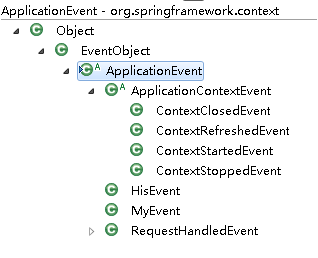一:Spring的事件发布
ApplicationContext提供了针对Bean的事件传播功能,其中的主角是publishEvent()方法,通过这个方法可以将事件通知给系统内的监听器(需实现ApplicationListener接口)。
ApplicationContext这个接口,是Spring的上下文,通常获取Bean就需要这个接口,这个接口并不是直接继承于BeanFactory,其中最著名的是直接继承了ApplicationPublisher接口,这个接口查看源码可以发现:只有一个方法,那就是主角 void publishEvent(ApplicationEvent event);
Spring提供的基于Aware相关的接口有ApplicationContextAware,ResourceloaderAware,ServletContextAware(注意:Struts2也有这个接口,注意区分),最常用的就这三个,而Spring的事件发布机制需要用到ApplicationContextAware接口。
实现了ApplicationContextAware的Bean,在Bean初始化时将会被注入ApplicationContext实例(因为这个接口里有set(ApplictationContext ctx)方法)
二:有了以上基础,看示例代码:
1.首先创建事件类 TradeEvent
|
1
2
3
4
5
6
7
8
9
10
11
12
13
14
15
16
17
|
package
net.wang.test;
import
org.springframework.context.ApplicationEvent;
/**
* 事件Event
* @author LiuRuoWang
*/
public
class
TradeEvent
extends
ApplicationEvent{
public
TradeEvent(Object source) {
super
(source);
System.out.println(
"事件:TradeEvent event !!"
);
}
}
事件必须继承Spring提供的ApplicationEvent抽象类
|
|
|
2
.然后编写 事件的发布者HelloWorld
|
|
1
2
3
4
5
6
7
8
9
10
11
12
13
14
15
16
17
18
19
20
21
22
23
24
25
26
27
28
29
30
|
package
net.wang.test;
import
org.springframework.context.ApplicationEventPublisher;
import
org.springframework.context.ApplicationEventPublisherAware;
/**
* 事件的发布者
* @author LiuRuoWang
*/
public
class
HelloWorld
implements
ApplicationEventPublisherAware{
private
String word;
public
void
setWord(String word) {
this
.word = word;
}
private
ApplicationEventPublisher tradeEventPublisher;
public
void
setApplicationEventPublisher(ApplicationEventPublisher applicationEventPublisher) {
this
.tradeEventPublisher=applicationEventPublisher;
}
public
void
say(){
System.out.println(
"say:"
+
this
.word);
TradeEvent tradeEvent =
new
TradeEvent(
new
String(
"HelloWorld!"
));
this
.tradeEventPublisher.publishEvent(tradeEvent);
}
}
|
|
1
|
其中在say()方法里发布了事件
|
|
1
|
3
.最后编写 事件的接收者EventReceiver:
|
|
1
2
3
4
5
6
7
8
9
10
11
12
13
14
|
package
net.wang.test;
import
org.springframework.context.ApplicationListener;
/**
* 事件的接收者
* @author LiuRuoWang
*/
public
class
EventReceiver
implements
ApplicationListener<TradeEvent>{
public
void
onApplicationEvent(TradeEvent event) {
System.out.println(
"监听到的事件:"
+event.getSource());
}
}
|
|
1
|
事件的接收者其实是一个监听器,必须实现ApplicationListener,注意把事件TradeEvent直接写到泛型中
|
|
1
|
4
.applicationContext.xml:
|
|
1
2
3
4
5
6
7
8
9
10
11
12
13
14
15
16
17
18
19
20
21
|
<?xml version=
"1.0"
encoding=
"GBK"
?>
<beans
xsi:schemaLocation="http:
//www.springframework.org/schema/beans
http:
//www.springframework.org/schema/beans/spring-beans-3.1.xsd
http:
//www.springframework.org/schema/aop
http:
//www.springframework.org/schema/aop/spring-aop-3.1.xsd
http:
//www.springframework.org/schema/tx
http:
//www.springframework.org/schema/tx/spring-tx-3.1.xsd">
<bean name=
"helloWrold"
class
=
"net.wang.test.HelloWorld"
>
<property name=
"word"
value=
"Word!"
/>
</bean>
<bean name=
"eventReceiver"
class
=
"net.wang.test.EventReceiver"
/>
</beans>
|
注意把事件的接收者写入配置文件中
5.测试Test:
|
1
2
3
4
5
6
7
8
9
10
11
12
|
package
net.wang.test;
import
org.springframework.context.ApplicationContext;
import
org.springframework.context.support.ClassPathXmlApplicationContext;
public
class
Test {
public
static
void
main(String[] args) {
ApplicationContext ctx=
new
ClassPathXmlApplicationContext(
"applicationContext.xml"
);
HelloWorld h = (HelloWorld) ctx.getBean(
"helloWrold"
);
h.say();
}
}
|
6.结果显示:
结果中已经显示监听到的事件,说明成功。
Spring 中的事件监听的实现
这里我们不讨论事件监听的机制的原理,我们只讨论如何在项目中实现时间监听。
Spring的事件监听是基于观察者模式。设计开发中。如下类与接口是我们必须要使用的。
ApplicationContext
首先我们了解一下ApplicationContext,还记得
- 1
ApplicationContext相当于Spring的一个与IOC容器连接的桥梁,通过getBean();方法,我们可以轻松的从IOC容器中获取Bean对象。
因为ApplicationContext是实现ApplicationEventPublisher的。查看ApplicationEventPublisher的源码,我们发现有一方法publishEvent。此方法便是发布事件的方法,即触发事件的方法,通过调用publishEvent方法,注入事件ApplicationEvent的子类,实现事件的触发。
- 1
- 2
- 1
- 2
- 3
- 4
- 5
- 6
说了一大堆,就是想说ApplicationContext的
publicEvent(ApplicationEvent event);
方法是可以用来发布通知,相当于触发事件的事件源。
ApplicationContextAware
ApplicationContextAware类似于ServeletRequestAware,通过让Action实现Aware,使得Action初始化之后便可以获得一些资源,这里我们让Action实现ApplicationContext,使得Action拥有ApplicationContext,Action中拥有ApplicationContext之后就可以调用publicEvent方法进行通知
- 1
- 2
- 3
- 4
ApplicationEvent
ApplicationEvent相当于一个事件,所有自定义事件都需要继承这个抽象类。在Eclipse中Ctrl+Shift+H调用类的层次结构列表,可以看到如下

Application下抽象子类ApplicationContextEvent的下面有4个已经实现好的事件
ContextClosedEvent(容器关闭时)
ContextRefreshedEvent(容器刷新是)
ContextStartedEvent(容器启动时候)
ContextStoppedEvent(容器停止的时候)
同样,这四个事件都继承了ApplicationEvent,如果我们想自定义事件,也可以通过继承ApplicationEvent来实现
嗯,同样是一句话总结ApplicationEvent就是一个抽象类,创建时间的时候只需要继承它就可以。
ApplicationListener
从名字可以看出来,这是一个监听器。为什么需要监听器呢?监听器是用于接收事件,并触发事件的操作,这样说起来可能有点费解,简单的说就是,Listener是监听ApplicationContext.publishEvent,方法的调用,一旦调用publishEvent,就会执行ApplicaitonListener中的方法,下面这个是ApplicationContext的源码。
- 1
- 2
- 3
- 4
- 5
- 6
- 7
- 8
- 9
这里是实际代码实现的过程
- 新建一个MyEvent的类,继承ApplicationEvent抽象类
- 1
- 2
- 3
- 4
- 5
- 6
- 7
- 8
- 9
- 10
- 11
- 12
- 13
- 14
- 15
- 16
- 17
- 18
- 19
2.新建一个监听器MyListener
- 1
- 2
- 3
- 4
- 5
- 6
- 7
- 8
- 9
- 10
- 11
- 12
- 13
- 14
- 15
- 16
- 17
- 18
- 19
- 20
- 21
- 22
- 23
- 24
- 25
- 26
- 27
- 28
- 29
- 30
- 31
- 32
- 33
- 34
- 35
- 36
- 37
- 38
- 39
- 40
- 41
- 42
- 43
- 44
- 45
- 46
- 47
- 48
- 49
- 50
- 51
- 52
- 53
- 54
- 55
- 56
- 57
- 58
- 59
- 60
- 61
3.最后,我们要再Action中发布通知publishEvent;
- 1
- 2
- 3
- 4
- 5
- 6
- 7
- 8
- 9
- 10
- 11
- 12
- 13
- 14
- 15
- 16
- 17
- 18
- 19
- 20
- 21
- 22
- 23
- 24
- 25
- 26
- 27
- 28
- 29
- 30
- 31
- 32
- 33
- 34
- 35
- 36
- 37
- 38
- 39
- 40
- 41
- 42
- 43
- 44
- 45
- 46
4.启动Tomcat时候命令行输出
- 1
- 2
- 3
- 4
访问页面的时候,命令行输出,可以看出,触发了MyEvent方法输出。























 7655
7655











 被折叠的 条评论
为什么被折叠?
被折叠的 条评论
为什么被折叠?








